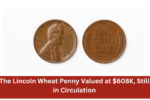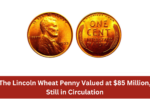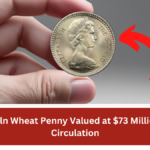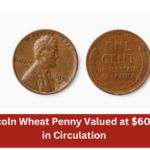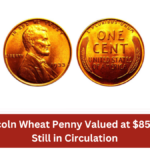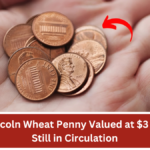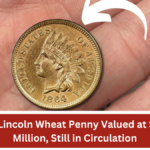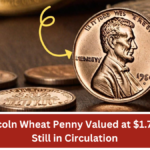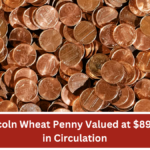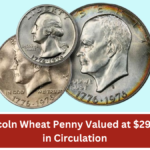The Lincoln Wheat Penny, minted between 1909 and 1958, remains a cornerstone of American numismatics. Collectors and enthusiasts have long sought after specific versions of this iconic coin, with some specimens reaching astronomical values. One such penny—valued at $299,000—has stirred intrigue among collectors and casual coin hunters alike. Here’s a deep dive into the history, features, and the specific details that make this penny so valuable.
Historical Background of the Lincoln Wheat Penny
The Lincoln Wheat Penny was introduced in 1909 to commemorate the centennial of Abraham Lincoln’s birth. Designed by Victor David Brenner, it was the first U.S. coin to feature a real person’s likeness. The obverse depicts a right-facing portrait of Lincoln, while the reverse features two wheat stalks flanking the words “ONE CENT.” This design replaced the Indian Head penny and became an instant favorite among Americans.
The coin’s popularity was bolstered by its design and historical significance. However, certain minting errors and rare editions have elevated its status in the world of collectibles.
The $299,000 Lincoln Wheat Penny: What Makes It Special?
Not all Lincoln Wheat Pennies are worth more than their face value. The staggering $299,000 valuation applies to a specific version of the coin with unique characteristics:
- Date and Mint Mark: The 1943-D Lincoln Wheat Penny minted in Denver is a key contender for this astronomical valuation. Most 1943 pennies were struck on steel due to wartime copper shortages. However, a few were mistakenly struck on bronze planchets, making them exceptionally rare.
- Error Coin: This bronze planchet error is the primary reason for the coin’s value. Only a handful of these bronze 1943-D pennies are known to exist, adding to their allure.
- Condition: The coin’s grade significantly impacts its value. Specimens graded MS-65 (Mint State) or higher are most desirable. These coins exhibit sharp details and minimal wear, further boosting their worth.
- Rarity: With fewer than 20 authenticated examples of the bronze 1943-D penny, its rarity is a driving factor for collectors.
How to Identify a Rare Lincoln Wheat Penny
If you think you might have a valuable Lincoln Wheat Penny, here are the key steps to identify it:
- Check the Date: Look for the year 1943.
- Examine the Metal: Bronze pennies have a reddish-brown hue, while the common 1943 steel pennies are silver-colored and magnetic.
- Inspect the Mint Mark: A “D” below the date indicates it was minted in Denver.
- Professional Grading: Consult a reputable coin grading service like PCGS or NGC to authenticate and grade the coin.
Tips for Finding Rare Pennies
Though rare Lincoln Wheat Pennies are not easy to come by, they can still appear in circulation or collections. Here’s how to improve your chances:
- Search Old Coin Rolls: Banks sometimes have rolls of coins that haven’t been searched for decades.
- Check Family Coin Collections: Older family members might have coin collections with hidden gems.
- Visit Flea Markets and Estate Sales: These places often have unsearched coin lots.
FAQs About the Lincoln Wheat Penny
1. What makes the 1943-D Lincoln Wheat Penny so valuable?
The 1943-D Lincoln Wheat Penny’s value stems from its rarity and the error in its production. It was struck on a bronze planchet instead of the intended steel, making it a highly sought-after collector’s item.
2. How can I tell if my 1943 penny is bronze or steel?
You can use a magnet to test your 1943 penny. Steel pennies are magnetic, while bronze pennies are not. Additionally, bronze pennies have a reddish-brown color compared to the silver-like appearance of steel ones.
3. How much is a typical Lincoln Wheat Penny worth?
Most Lincoln Wheat Pennies are worth between $0.10 and $5, depending on their condition and year. However, rare editions like the 1943-D bronze penny can fetch hundreds of thousands of dollars.
4. What should I do if I find a rare Lincoln Wheat Penny?
If you believe you’ve found a rare penny, have it authenticated by a professional coin grading service. Avoid cleaning or altering the coin, as this can reduce its value.
5. Are there other valuable Lincoln Wheat Pennies besides the 1943-D bronze penny?
Yes, other valuable Wheat Pennies include the 1909-S VDB penny and the 1922 “No D” penny. These coins are also highly sought after due to their rarity and unique features.
Conclusion
The Lincoln Wheat Penny remains an enduring symbol of American history and culture. While most of these coins are worth only a few cents, rare editions like the 1943-D bronze penny can transform an ordinary collection into a treasure trove. Whether you’re a seasoned numismatist or a curious beginner, the hunt for these extraordinary coins continues to captivate imaginations. Who knows? The next time you check your pocket change, you might just strike gold—or in this case, bronze.


